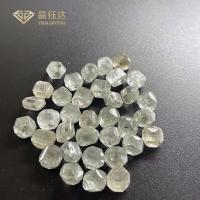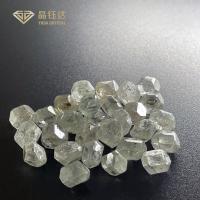2ct 3ct Fancy Yellow Color Lab Grown Colored Diamonds With VVS VS
Clairty
Lab Grown Colored Diamonds Description
There are two main methods to prepare synthetic diamond: high
pressure high temperature method (HPHT) and chemical vapor
deposition (CVD).
High temperature and high pressure catalytic technology (HPHT)
simulates the natural environment in which diamonds form 150
kilometers below the earth's surface. At about 2000 degrees Celsius
and 5.8 atmospheres of high temperature and pressure, the crystal
structure of diamonds will be dislocated, or tiny graphite will be
used to make synthetic diamonds. It's mainly made of carbon. The
quality of synthetic diamonds is almost the same as that of natural
diamonds.
In theory, diamonds need to be produced under high pressure.
Chemical vapor deposition (CVD) is a method of diamond growth by
CVD. The basic principle is that methane decomposes in high
temperature and vacuum, carbon atoms and hydrogen atoms are
separated, and carbon atoms are deposited on the seed crystal to
form diamond.
The purity and color of the diamond synthesized by CVD technology
have reached the level of high-grade natural diamond, which is
better than HPHT method to cultivate large grain diamond.
CVD synthetic diamond can be used in jewelry industry and
industrial cutting. With the progress of technology, color and
purity are improving, and the output will be larger and larger,
which can provide more choices.
Parameters of Lab Grown Colored Diamonds
| Lab Grown Colored Diamonds Details |
| Brand Name | Yuda Crystal |
| Name | Lab Grown Colored Diamonds |
| Diamond Color | Yellow, Greenish, Brown |
| Diamond Clarity | VVS-SI |
| Diamond Carat Weight | 2.0-3.0carat |
| Diamond Cut | Uncut |
| Technology | HPHT |
| Size | 5.0-15.0mm |
| Shape | Raw |
| Application | For Cutting Lab Grown Loose Diamonds |
| Place Of Origin | Zhengzhou, China |
| Delivery Time | 1 - 7 Working Days Base on Order Quantity |
| Payment Terms | 100% Payment In Advance |
| Payment Methods | T/T, PayPal, Western Union, Bank Transfer |
| Shipping way | DHL, FedEx, SF Express, UPS, EMS, TNT etc |
| M.O.Q | Negotiable |
| Diamond Type | Synthetic(lab created) |
| Location | Zhengzhou, China |
| Treatments Applied | None |
| Fire Dispersion | 0.044(Same as Natural Diamond) |
| Brilliance Refraction Index | 2.42(Same as Natural Diamond) |
| Relative Density | 3.52(Same as Natural Diamond) |
| Chemical Composition | Carbon(Same as Natural Diamond) |
| Moh's Hardness | 10(Same as Natural Diamond) |
Lab Grown Colored Diamonds Introduction
Natural diamonds are created by nature and are the result of high
temperature and pressure formed over billions of years. The Rough
Lab Grown Diamonds are produced in the laboratory, usually in a few
weeks. The chemical difference between the two is same.
So how do you distinguish between Rough Lab Grown Diamonds and
natural diamonds?
There is no obvious difference between the Rough Lab Grown Diamonds
and natural diamonds. Even professional gemologists need special
equipment to identify them. By zooming in, professionals will be
able to discern subtle contrasts in diamond inclusions grown and
mined in the laboratory.
| The Difference Between Lab Diamond And Natural Diamond |
| Properties | Earth Mined | Lab Created |
| Guaranteed Conflict-Free | No | Yes |
| Hardness (MOHS) | 10 | 10 |
| SP3 Carbon Diamond Bonds (%) | 100% | 100% |
| Internal Crystal Structure | Face-Centered Cubic | Face-Centered Cubic |
| Hardness Comparable | 2.42 | 2.42 |
| Relative Diversity | 3.52 | 3.52 |
| Color Diffusion | 0.044 | 0.044 |
| Color | Various Grades | K to D grades |
| Price | $$$$$ | $$$ |
Lab Grown Colored Diamonds Details












